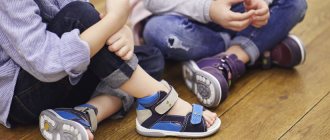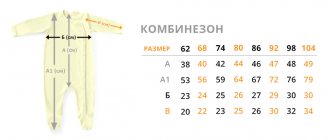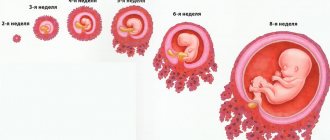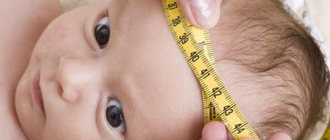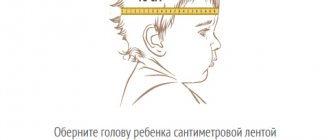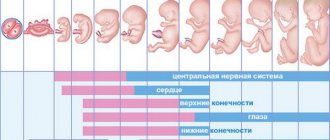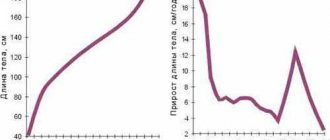Young parents have to face unexpected questions that they had never even thought about before. For example, there was a need to buy a hat for a child, but how to find out the appropriate child size? In general, what should you pay attention to when choosing a miniature cap for a newborn or a thick, insulated knitted hat, or a winter model?
In fact, everything is not that difficult. A special table will help you determine exactly the right hat size for children, the data of which is very easy to navigate. We'll tell you how.
The importance of headdress
With the birth of a baby, parents have a lot of worries regarding clothing. After all, it is impossible to try it on, so you need to know the size. Mothers are usually inexperienced in this matter, which is why many manufacturers simply indicate the age on the label, which greatly simplifies the purchasing process.
But if with clothes it’s a little easier, then with a headdress everything is different. Of course, there are sizes of children's hats according to age, but each child has his own head size. Therefore, you need to choose especially carefully. In winter, it is very dangerous for a baby to get a cold in the head, and in summer it needs to be hidden from the hot sun. Therefore, the headdress should not squeeze the head or, conversely, creep into the eyes
Tips “just in case of fire”
If you are in a store and have already looked at the desired accessory: a beret, a hat or another headdress, then, of course, you need to try on this product before purchasing. But what if you didn’t take your child with you when shopping? You don’t want to make a mistake by choosing the wrong hat size for children’s hats.
In this case, use one of two methods for calculating the size of the hat:
1) you need to fold the cap flat, close its edges and measure using a ruler. The resulting value is multiplied by two, and another centimeter is added to the result. The total number of centimeters is the estimated volume of the child's head;
2) look for an indication of the size of the hat on the headdress. This information is usually left on a label on the outside or inside of the product. It happens that the exact volume is indicated in centimeters, and sometimes it is a simple designation. For example, "2M" means two months.
If you are knitting a hat for your child or are going to buy him a ready-made high-quality product, then it is very important to know the parameters and volume of your child’s head. We hope that the tips and sign from this article will help you correctly calculate the parameters of a children's headdress.
How to determine the size of a children's hat?
Hat size is the circumference of the head, measured in centimeters. The measurement is taken as follows: the tape, which does not need to be pulled too tightly, is pulled over the eyebrows, ears and through the most convex area of the back of the head. The resulting number is the value that should be looked for on the product tag.
Sometimes in the store you can find hats indicating only the age of the child for whom they are intended. But children develop at different rates, and their parameters can differ significantly.
The size range of children's hats is very diverse. Some manufacturers sew products according to the size grid every 1 cm around the circumference of the child's head. Most manufacturers sew children's hats and bonnets on a mesh every 2 cm in even sizes (for example, 36, 38, 40, 42, 44, 46, 48, etc.) or even every 4 cm (size 36, 40, 44, 48).
If you come across a letter designation for the size of a children's hat, then this table will help you determine the child's size:
| Size | XXS | XS | S | M | L | XL |
| Head circumference | 40-43 | 44-46 | 47-49 | 50-52 | 53-55 | 56-58 |
Caps and caps must be exactly the size of the child. If the cap is too big, then it can even be dangerous for the baby’s life, because... A loose cap can slide down onto the face during sleep and interfere with the baby’s breathing. Caps should not be tight, it hurts, and loose caps let cold into the ear. Therefore, a children's headdress must fit.
When choosing a demi-season or winter hat for children, it is important to consider what you are going to wear under such a hat (a cap or a thin cap).
Measure the child's head twice: without a headdress and in a cap, which you will wear under the hat. It is difficult to measure the circumference of your head with a cap, so compare it with the size without a cap. The head circumference in the cap should be about a centimeter larger. And with this size, feel free to go buy a children's winter or demi-season hat.
To learn how to correctly determine the size of women's panties, read the article: How to determine and what sizes of women's panties are there
If you don’t know how to determine the size of men’s swimming trunks, find out about it in the review: How to determine and what sizes of men’s briefs and swimming trunks are there
We'll tell you how to determine the size of men's shirts here:
Different size numbering systems
Size 44 hats are most often suitable for six-month-old babies. However, if you compare the result with the actual growth of your child, you can adjust the desired size down or up.
Many manufacturers use a numbering system that consists of even numbers with intervals of two units. There is also another option: it is possible to use double children's sizes: 46-48, 48-50 and the like.
If the head circumference is between two values, then before buying a headdress for the summer, take the model that is smaller. After all, the fabric for such products stretches well. Winter or demi-season hats, for example, with padding polyester, must be taken in large sizes, because under them the child wears a cap (for a newborn) or a light hat.
How to determine what head size your child will have
To determine the size of children's hats and bonnets according to the child's age, we provide tables below that correspond to the age and size of hats and bonnets. The size of the headdress based on head circumference is given based on the average for Russian children. Interestingly, in the first three months, the circumference of a child’s head increases by an average of 2 cm per month. Then, from three months to one year, the child’s head increases by 0.5-1 cm per month. Later, head growth slows down even more. By the age of two, the circumference of a child’s head increases by an average of 2.5 cm. And from two to 10 years, a child’s head grows only 0.5 cm per year. Boys have larger heads.
We provide tables of sizes of hats and bonnets separately for boys and girls.
| Size chart for children's hats and caps for boys |
| Boys age | 0 months | 1 month | 2 months | 3 months | 6 months | 9 months |
| The average size | 34-39 | 37-41 | 39-43 | 41-45 | 43-47 | 45-48 |
| Boys age | 1 year | 1.5 years | 2 years | 3 years | 4 years | 5 years |
| The average size | 47-49 | 48-50 | 48-51 | 49-52 | 50-53 | 50-54 |
| Boys age | 6 years | 7 years | 8 years | 9-10 years | 11-12 years old | 13-14 years old |
| The average size | 52-54 | 52-55 | 52-55 | 53-56 | 54-57 | 54-58 |
| Size chart for children's hats and caps for girls |
| Girls age | 0 months | 1 month | 2 months | 3 months | 6 months | 9 months |
| The average size | 32-38 | 35-40 | 37-42 | 39-44 | 41-46 | 43-47 |
| Girls age | 1 year | 1.5 years | 2 years | 3 years | 4 years | 5 years |
| The average size | 45-48 | 47-49 | 48-50 | 49-51 | 50-52 | 50-53 |
| Girls age | 6 years | 7 years | 8 years | 9-10 years | 11-12 years old | 13-14 years old |
| The average size | 51-53 | 51-53 | 51-54 | 52-54 | 52-55 | 52-55 |
A newborn baby constantly outgrows the caps, because they are cotton knitted and have almost no stretch. If the cap is small or large, then the style of the cap itself forces the mother to put on a cap that is the right size for the child and change it to a larger one in time.
Another thing is hats for winter, spring and autumn. The newborn will definitely outgrow his first hat, but next season’s hat, perhaps, if it stretches a little, he will be able to wear in a year. In the first three years of a child’s life, one winter hat will probably be enough for two winters, and a child will definitely wear a demi-season hat through spring and autumn and, perhaps, into a third season.
Subtleties of choosing a hat for a child
In order to select the right size of headgear as accurately as possible, it is worth remembering that in the first 3 months of life the baby’s head circumference increases by an average of 2 cm every month, from 3 months to a year - by 0.5-1 cm every month, by 2 years the head grows by another 2.5 cm, and from 2 to 10 years the measurement result changes annually by only 0.5 cm.
Children's hats need to be chosen especially carefully. After all, if, for example, you buy a large cap, it can be dangerous for the child’s life, because when the baby turns his head, the product can cover his face and make it difficult to breathe. A winter hat of a smaller size will press on, creating a feeling of discomfort, while a larger one will not fit tightly to the body, as a result of which the child may have blown out ears.
Trying on is the best way to choose the right size of headgear for children. But if for various reasons it is impossible (for example, when buying things online), the table below will help you avoid mistakes.
Features of dimensional grids
Determining the correct hat size for your child is the main condition for purchasing a headdress. However, you also need to understand the features of the sizing chart so as not to run into other issues.
A child's head, especially in the first year of life, grows very quickly. Don’t be surprised if your recently purchased cap suddenly becomes small – this is absolutely normal. That is why markings change very quickly and “grow” by several centimeters in just a month.
When buying children's hats, make a choice in favor of a larger indicator, then the model will definitely fit.
Better yet, try to purchase in stores where you can try on the product.

